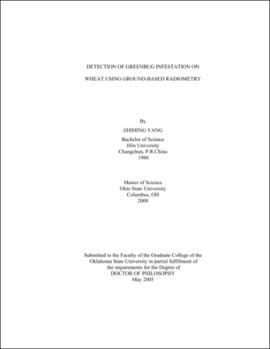| dc.contributor.advisor | Rao, Mahesh N. | |
| dc.contributor.author | Yang, Zhiming | |
| dc.date.accessioned | 2013-11-26T08:29:53Z | |
| dc.date.available | 2013-11-26T08:29:53Z | |
| dc.date.issued | 2005-05 | |
| dc.identifier.uri | https://hdl.handle.net/11244/7127 | |
| dc.description.abstract | Scope of Methods of Study: The purpose of this greenhouse study was to characterize stress in wheat caused by greenbugs using ground-based radiometry. Experiments were conducted to (a) identify sprectral bands and vegetation indices sensitive to greenbug infestation; (b) differentiate stress caused due to greenbugs from water stress; (c) examine the impacts of plant growth stage on detection of greenbug infestation; and (d) compare infestations due to greenbug and Russian wheat aphid. Wheat (variety-TAM 107) was planted (seed spacing 1 in. x 3 in.) in plastic flats with dimension 24 in. x 16 in. x 8.75 in. Fifteen days after sowing, wheat seedlings were infested with greenbugs (biotype-E). Nadir measurement of canopy reflectance started the day after infestation and lasted until most infested plants were dead. Using a 16-band Cropscan radiometer, spectral reflectance data were collected daily (between 13:00-14:00 hours) and 128 vegetation indices were derived in addition to greenbug counts per tiller. Using SAS PROC MIXED, sensitivity of band and vegetation indices was identified based on Threshold Day. Subsequent to Threshold Day there was a consistent significant spectral difference between control and infested plants. Sensitivity of band and vegetation indices was further examined using correlation and relative sensitivity analyses. | |
| dc.description.abstract | Findings and Conclusions: Results show that it is possible to detect greenbug-induced stress on wheat using hand-held radiometers, such as Cropscan. Band 694 nm and the ratio-based vegetation index (RVI) derived from the band 694 nm and 800 nm were identified as most sensitive to greenbug infestation. Landsat TM bands and their derived vegetation indices also show potential for detecting wheat stress caused by greenbug infestation. Also, RVIs particularly derived using spectral band 694 nm and 800 nm were found useful in differentiating greenbug infestation from water stress. Furthermore, vegetation indices such as Normalized total Pigment to Chlorophyll Index (NPCI) could be used to distinguish greenbug infestation and infestation caused by Russian wheat aphid. Finally, stress was detected in a shorter time interval when wheat plants were infested with greenbugs at two-leaf stage than wheat plants infested at tillering stage. This study demonstrated the utility of adopting remote sensing techniques for detecting greenbug infestation on wheat. Further field-based studies are suggested to apply the technology that has great potential for integrated pest management. | |
| dc.format | application/pdf | |
| dc.language | en_US | |
| dc.rights | Copyright is held by the author who has granted the Oklahoma State University Library the non-exclusive right to share this material in its institutional repository. Contact Digital Library Services at lib-dls@okstate.edu or 405-744-9161 for the permission policy on the use, reproduction or distribution of this material. | |
| dc.title | Detection of greenbug infestation on wheat using ground-based radiometry | |
| dc.contributor.committeeMember | Lightfoot, Dale | |
| dc.contributor.committeeMember | Elliott, N. C. | |
| dc.contributor.committeeMember | Kindler, S. Dean | |
| dc.contributor.committeeMember | Giles, Kristopher L. | |
| osu.filename | Yang_okstate_0664D_1361 | |
| osu.accesstype | Open Access | |
| dc.type.genre | Dissertation | |
| dc.type.material | Text | |
| thesis.degree.discipline | Environmental Science | |
| thesis.degree.grantor | Oklahoma State University | |
